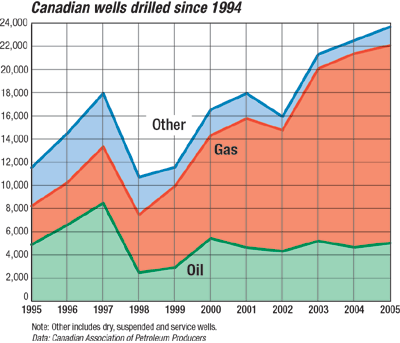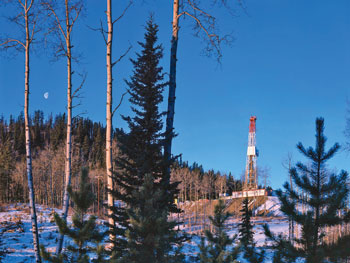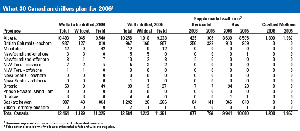International: Canadian outlook
OUTLOOK 2006: International
|
|
OVERVIEW/ SPENDING
Since the beginning of 2005, prices for oil and gas have strengthened. Oil is trading above C$70/bbl, and gas is starting 2006 at C$9/gigajoule (GJ), although it soared above the C$15/GJ plateau last December. A recent Conference Board of Canada report forecasts that the high-price environment will continue for at least another 10 to 15 years, depending on how political issues regarding climate change unfold.
Strong prices and high activity also produced a record year for energy stocks, as the Toronto Stock Exchange’s (TSX’s) energy index rose more than 60% in 2005. The oil-and-gas sector’s high value also contributed to the TSX reaching a new high in early January. The oil-and-gas sector comprises about 25% of the TSX composite index.
The banner year has also boosted spending plans for 2006. The Canadian Association of Petroleum Producers (CAPP) estimates that spending will hit a record level at C$39 billion this year, with just over C$30 billion ticketed for conventional oil and gas development, plus almost C$9 billion for oil sands expenditures. In 2005, total industry spending hit C$37 billion, compared to C$33 billion in 2004.
Top Canadian spenders (including international projects) are estimated to be Canadian Natural Resources Limited, with a budget of C$6.8 billion (up 106%); Talisman Energy Inc., at C$4.4 billion (up 36%); Suncor Energy Inc., at C$3.5 billion (up 30%); Petro-Canada, at C$3.4 billion (flat); Nexen Inc., at C$2.9 billion (up 3.6%); Husky Energy Inc., at just under C$2.9 billion (up 25%); and Shell Canada, at C$2.7 billion (up 60%). A figure from EnCana Corporation was not available at press time.
As usual, strong balance sheets, hefty cash flows and the need to grow sparked a number of acquisitions, asset sales and takeover rumors in 2005. The most grist for the rumor mill has been supplied by EnCana, where speculation persists that the Canadian independent may be the target of a takeover bid. The rumor is fueled by the recent departure of long-time CEO Gwyn Morgan. The company however, continues to assert that it is not for sale.
One of the reasons that the EnCana rumor has persisted was December’s announcement of the massive US$35.6-billion takeover of Burlington Resources Inc. by ConocoPhillips Company. That deal creates the second-largest holder of proved Canadian gas reserves, second only to EnCana. ConocoPhillips also becomes the fifth-largest oil and gas producer in Canada, and the 17th-largest holder of conventional oil and gas liquids reserves.
Speculation has also centered on Canadian Natural Resources Limited, with its extensive oil sands holdings. CNRL also denies that any deal is in the offing.
One of the largest takeovers in 2005 was Kinder Morgan Inc.’s $6.9-billion cash-and-stock acquisition of Vancouver-based Terasen Inc. in October, a pipeline company with operations in Canada and the US. Other deals in the last half of 2005 include:
- Pogo Producing Company shelled out C$2.2 billion last July, when it acquired Northrock Resources Ltd. from Unocal Corporation.
- In August, Precision Drilling Corporation sold its Energy Services and International Drilling divisions to Weatherford International Ltd. for C$2.7 billion, including 26 million common shares of Weatherford and $1.1 billion in cash.
- In October, Talisman paid C$2.5 billion for UK-based Paladin Resources PLC. Paladin has assets in the Norwegian, UK and Danish sectors of the North Sea, as well as in Australia, Indonesia and Tunisia.
- Viking Energy Royalty Trust and Harvest Energy Trust announced plans in November to merge into Canada’s fourth-largest energy trust, valued at more than C$4 billion.
The surging Canadian dollar, which hit 87.11 US cents on Jan. 25 (the highest rate since January 1992), has negatively impacted the value of exports to the US, but it also serves to insulate Canadian companies against hostile take-over bids from their American peers.
And yet, despite the Canadian dollar’s strength, the value of Canadian exports to the US was projected to hit a new all-time high in 2005, due primarily to high gas prices. National Energy Board statistics indicate a nine-month total of $23.2 billion in gas exports. Even conservative forecasts of fourth-quarter totals will exceed 2004’s record of $30.2 billion.
DRILLING
In keeping with the record trend of 2005, drilling also reached an all-time high. According to the Daily Oil Bulletin, there were 21,999 wells completed in Canada in 2005, 1.5% higher than the previous record of 21,664 set in 2004. Natural gas drilling slipped slightly last year, to 15,359 wells, down slightly from the record of 15,674 set in 2004, but this still represents almost 70% of total Canadian drilling during 2005. There were also 4,822 oil wells (up 8.7%), 1,414 abandonments and 330 service wells. Almost 25% of the total wells were exploratory (5,416). In addition to 15,674 gas wells (72.4%), the 2004 numbers included 4,438 oil wells (20.5%) and 1,282 dry holes (5.9%).
 |
High activity levels are expected to continue in 2005, and both Canadian drilling and service associations are predicting another record. Once again, a lack of skilled labor has been identified as a significant challenge for drilling and service contractors. The upside to the higher demand is that contractors mirrored the outstanding financial performance enjoyed by producers in 2005.
The Canadian Association of Oilwell Drilling Contractors (CAODC) is more bullish, forecasting 26,070 wells in 2006. CAODC based its forecast on an average WTI price of US$55/bbl, and an average NYMEX spot gas price of US$7.50/Mcf. As is typical, its price assumptions are conservative compared to many others. CAODC is also predicting that rig utilization will average 65% in 2006, with an average rig count of 533, up 1% over last year. In response to continued high demand for rigs, the rig fleet is expected to swell to 820, after topping the 700 mark for the first time in December 2005. Overall, in 2005, rig utilization was 68%, with an average 502 rigs working.
The Petroleum Services Association of Canada (PSAC) has come out with a more conservative forecast for 2006, projecting 25,290 wells will be drilled (up 5.9%). PSAC believes that shallow gas well drilling in Alberta, including development of coalbed methane (CBM) reserves, will continue to drive activity. PSAC’s forecast is based on a WTI average of US$60/bbl, and C$9.50/Mcf at Alberta’s AECO storage hub.
As usual, the high demand has made it difficult for smaller oil and gas producers to track down available rigs, particularly if they are only looking to drill a handful of wells. Larger producers tend to lock up rigs for long periods of time to accommodate extensive drilling programs.
The tight supply is not expected to ease up any time soon, with the National Energy Board projecting continued high demand for rigs will continue through 2007, even with substantial increases to the size of the rig fleet.
Meanwhile, World Oil conducted its annual survey of Canadian producers. Surprisingly, survey results are somewhat more bearish than those of CAODC or PSAC, with participants indicating they plan to drill 12,464 wells in 2005, down 1% from the 12,584 wells they drilled in 2005. Although this translates to a projection of about 23,500 wells this year, the editors are making a judgment call and predicting 24,250 wells.
This is the second year in a row that World Oil’s survey participants have come in with a lower forecast of activity than the associations. Given that 2005 set another drilling record, it may indicate that companies are taking a cautious approach to begin the New Year, with activity increasing if market conditions remain favorable.
The survey also indicates a drop-off in gas drilling, although it still represents 80% of total drilling for the year (9,941 wells). The numbers also show a slight decrease in exploratory drilling, with 8.6% of wells drilled to be wildcats (1,139). In 2005, the percentage of wildcats drilled by survey participants was slightly more, at 9.7% (1,223). This represents a continuation of the decade-long trend toward development drilling in Canada. Activity within this group is expected to increase 2.3% in Alberta, decline 3.1% in British Columbia, and decrease 29.8% in Saskatchewan. The big drop in Saskatchewan is due primarily to reduced drilling plans by Apache Corporation and Husky Oil in the province.
Regardless of how accurate the conventional drilling forecasts are, it is certain that the industry’s focus on oil sands has not just remained strong, but has intensified. With oil prices as high as they are, and demand continuing to increase, producers can more comfortably commit to the massive capital costs associated with large-scale oil sands development. Canadian crude’s accessibility to markets has also improved. This is to the point, where both Japanese and Chinese companies are pursuing interests in Alberta’s massive oil sands deposits, in addition to North American companies that traditionally dominated oil sands projects.
The rising interest has generated some hefty bids at Alberta land sales, with bids for oil sands leases frequently topping the list for both total dollar value and per-hectare prices in 2005. In December, two oil sands leases, one for $25.6 million and another for $21.4 million, indicated the type of interest that has smashed previous records for land sale bonuses collected in 2005.
PRODUCTION/ DEVELOPMENT
North of Fort McMurray, Syncrude Canada Ltd. is on track to complete the Stage 3 expansion of its oil sands mine in early 2006, although the cost has risen another 2%, to $8.3 billion. The expansion will go into production at the mid-year point, and should increase output at the site to 350,000 bpd.
Meanwhile, EnCana has announced plans to expand its oil sands output from the current 42,000 bpd to 500,000 bpd by 2015, for an estimated cost of C$5 billion to C$7.5 billion. CNRL has said that it will spend an initial C$600 million on its Primrose East project. This will increase output in the company’s Wolf Creek/ Primrose operating area from the current 82,000 bpd to 120,000 bpd, as early as 2009.
Husky has also received regulatory approval to proceed with its $10-billion Sunrise thermal project northeast of Fort McMurray, which could produce first oil by 2009. The company plans to develop the 200,000-bpd project in phases. Husky has also reported that its $500-million Tucker project, northwest of Cold Lake, is on budget and on schedule to produce first oil by the end of 2006.
|
High activity levels have also sparked other projects dependent on oil sands growth. In late December, Synenco Energy Inc. announced plans to build the Northern Lights upgrader just northeast of Edmonton to complement the oil sands mining project planned on its leases northeast of Fort McMurray.
Meanwhile, Enbridge Inc. said that the application for its $4-billion, 750-mi Gateway pipeline project – consisting of a 400,000-bpd oil/ blended bitumen export pipeline and 150,000-bpd condensate import pipeline – will be submitted to the National Energy Board this April. Enbridge hopes to have the line in service by 2010.
On the east coast, there was some good news, as Husky’s White Rose field shipped its first crude to Irving Oil’s terminal near Saint John, New Brunswick. Production from the field, averaging 75,000 bopd, is expected to peak at 100,000 bopd during first-half 2006. A number of refiners in Canada and the northeastern US have expressed interest in processing White Rose’s high-quality, low-sulfur oil.
Finally, land sales, in keeping with the record-setting theme of 2005, obliterated previous highs, generating C$2.93 billion for provincial authorities last year. That figure is up 106% over the C$1.42 billion collected in 2004. Alberta once again led the way, collected an astonishing C$2.26 billion, which would have set a new Canadian record on its own. ![]()
Mr. Curran is a Calgary-based freelance writer. |
Comments? Write: editorial@worldoil.com |
- Prices and governmental policies combine to stymie Canadian upstream growth (February 2024)
- U.S. producing gas wells increase despite low prices (February 2024)
- U.S. drilling: More of the same expected (February 2024)
- U.S. oil and natural gas production hits record highs (February 2024)
- U.S. upstream muddles along, with an eye toward 2024 (September 2023)
- Canada's upstream soldiers on despite governmental interference (September 2023)




